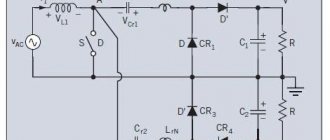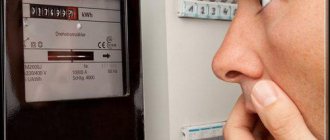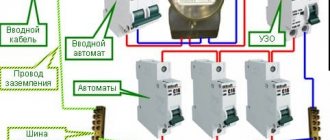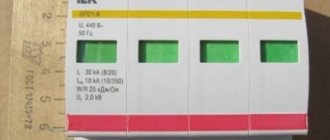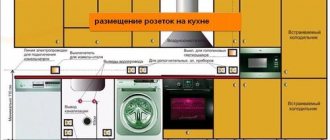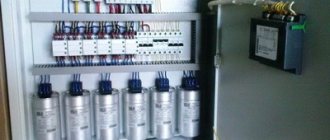Sometimes, due to insufficient power in the general city network, it is necessary to limit it at individual sites. First of all, these are newly connected subscribers who can overload the existing line. To solve this issue, a power limiter is used to control its consumption. If the set point is exceeded, the device simply turns off the consumer. Another important function of a power limiter is to protect electrical wiring from unauthorized connections by unauthorized persons. Power limiters can be used in single-phase and three-phase networks.
Purpose and application
This is a rather complex electrical appliance that is installed in the electrical panel on the line after the electricity consumption meter. The purpose of a power limiter is to monitor and control power consumption.
Ordinary circuit breakers, which operate on the principle of a thermal switch, also cope with these functions. But this device is more functional and reliable.
Basic functions of the device
Power limiters, regardless of modification, primarily monitor active power consumption and limit it when consumption exceeds a set value.
Modern limiters have a large number of functions:
- Protection against voltage surges due to adjustable settings and time delay.
- Protection in case of short circuit or overload, providing maximum current protection. Unlike automatic machines, there are more flexible settings for settings regarding current and response time.
- The device protects against ground faults, similar to the action of an RCD.
- The limiter performs the functions of a relay, providing protection in the event of a broken phase sequence. In addition, the limiter protects the network in case of line voltage imbalance.
The power limiter can monitor the health of the contactor in case of any malfunction when the circuit remains open. In such a situation, the device automatically turns off the power supply.
All protections included in the limiter are initially disabled in accordance with the factory settings. Only line voltage surge protection is enabled. Each function is put into operation separately, by activating it in installation mode. Next, fine adjustments are made, including re-activation, activated separately.
The OM-310 model has become widespread. This device allows you to measure and calculate phase and line voltages, currents flowing to each phase and many other parameters. All calculation and measurement data are displayed on the front side of the relay on the indicator light display. For example, the marking “PoA” on the left side means the current active power consumed, and on the right side its value in kilowatts is displayed.
Choice
Power limiters are available in various types. When choosing a specific model, you must first determine the number of phases, operating voltage and the range in which the power is regulated.
The remaining parameters are optional and do not fundamentally affect performance. Equipment for them is selected at will from existing equipment.
- Details about scissor lift
- How to choose a monument?
- Why do you need online personnel testing?
You need to choose a specific model of power limiter after the energy supply project has been approved based on all the technical requirements and wishes of the consumer.
CS-CS.Net: Laboratory of the Electroshaman
Three-phase power limiter NovaTek OM-310 (priority relay)
Since we started the topic of returning to previous publications with a post about differentials, we are returning to priority relays and other things that do something when the current consumed is exceeded. I remind you of an old post about the ABB LSS1/2 priority relay. The task of such relays is to limit power consumption. They are usually used if the allocated power (the rating of the input circuit breaker) is small, and there is a risk that due to the heavy load it will turn off, leaving the entire home without light. Then you can set the priority relay so that when there is an overload, it tries to turn off some lines (for example, sockets or appliances such as air conditioners or ovens), leaving lighting and, for example, sockets for a computer.
Most often, this problem occurs on single-phase inputs, for example, in all sorts of country houses with a weak TP, or in apartments with gas in old houses, where the rating of the input circuit breaker can be 25A (and in St. Petersburg with Gothic panels on marble boards, even 16A). However, now it has become popular to allocate three-phase inputs with 15 kW of power to country houses. This is an introductory machine with a nominal value of 25A. And the same problem arose - to turn off part of the loads when the three-phase power was exceeded. This means you need a three-phase priority relay .
But first, let's return to the small find of a single-phase option. This is the NovaTek RMT-101 maximum current relay . You can read about it and download the document here: https://novatek-electro.com/rele_maksimalnogo_toka_rmt-101.html. In fact, this is the same LSS1/2, only of our production and with an indication of the measured current.
Maximum current relay NovaTek RMT-101
It can be used as:
- Just an ammeter - there was an example in one of the last posts, which described a three-phase 19″ switchboard with an indication of voltages and currents. In this case, we ignore all the settings and contacts of the relay, and simply measure the current with it.
- Priority relay . In this case, we will need to install a contactor. Well, it is installed in the same way for LSS.
However, this relay has several advantages over LSS. Firstly, the current here is measured using a current transformer, and the wire is not broken or connected anywhere. In this case, the relay may not be powered from the same source whose current it measures. Here it is - the hole through which you need to pass the wire:
Channel for pushing a wire in which current is measured
Secondly, this relay adjusts the on and off time for overload, which also gives greater flexibility in settings. And if you need to organize several priority levels, you can simply cascade several of these relays. With a price of about 2500, it’s all bullshit =)
Let's take a look inside. Here's all the filling:
Internal filling RMT-101
And here is the current transformer:
Current transformer through which the measurement is carried out
It was made somewhere in India, but as I understand it, its accuracy is sufficient for such measurements. This relay is quite convenient and easy to use. I often use it as an ammeter in my panels.
However, to be fair, I will describe my impressions of the ABB AMTD-1 ammeter, which costs 5-6 thousand. It's AWESOME because it has very big and bright numbers. They can be read from afar. Therefore, if you want to have a beautiful device, choose ABB. If you just need an indication in some UK540, install this relay.
Well, now let's move on to the three phases. And then immediately the Joss story about how I collided with another manufacturer and what came of it. Actually, it is clear that my blog is entirely dedicated to ABB equipment. And I even declare that I collect all the shields only from ABB. It happened so, and now I can say that it is better to have a professional understanding of one thing than a superficial understanding of many.
But I had to deal with a lot. They asked me to check someone else's project and assemble a shield based on it. I cannot publish the project, so I will describe it in words. Surprisingly, this was the first time I saw a project in which groups were made normally. and it seems that people read my blog =)) This is good.
The project had a three-phase input and a three-phase priority relay. He had two non-priority outputs drawn, on each of which (without a contactor) there were several loads scattered across phases. In theory, it should have worked like this: if the load on any of the phases exceeds the specified one, we cut off non-priority output 1. If that doesn’t help, we cut off the second one.
And the project indicated a CDS 15913 relay from Schneider. Well, I kind of read the description and cursed because Schneider counts the modules not as 18 mm, but as 9 mm. And that its 16 modules are actually 8 real ones. And that there was no need to think about how to file the plastron from the shield.
Nooooo... it turned out that the designer was wrong. Look at this fucking relay. It costs 13..17 thousand. But in fact, these are just three single-phase priority relays in one housing. What they have in common is only zero nutrition. And some fucking screws. How straight from the USSR. To twist with a screwdriver like this one with wooden handles (it was a pin like “how a pro sees something he’s not used to” - “Hmm.. some kind of crap.. and the screws are kind of strange, not like that” xDD).
Three-phase priority relay from Schneider (CDS 15913)
And my hair stood on end. I bought some CRAP that will never work as it should. I even asked the Schneider specialist from MasterCity (user Yurka ), and he described to me what I already understood: Schneider has either a three-phase relay or a single-phase relay with the same functionality as ABB LSS1/2 - two non-priority groups . And the designer made something of his own out of them.
So what should I do? First of all, RENT OUT this expensive horror! And secondly... heheee... go to NovaTek and buy their miracle of technology - a three-phase power limiter NovaTek OM-310 . I show you the highlight of today's program:
Power limiter OM-310
I immediately give all the links to the description (https://novatek-electro.com/rele_ogranicheniya_moschnosti_om-310.html) and to the program for communicating with a computer (https://novatek-electro.com/docs/soft/Setup_cpl_pl310(1.6) .rar). And I will briefly describe what it can do, in my own way:
- Work in one or three phases. He doesn’t really care what to measure.
- Has a control interface from a computer. Very convenient, especially for setting parameters. There are screenshots at the end of the article. Moreover, the data can be logged to collect statistics. This is similar to a cheap version of the OMIX power quality analyzer or the RPM-16-4-3 Recorder.
- It can be used as a hellish input thing that will protect against emergency voltage and even against leakage to the ground, like a fire protection RCD (for this, an additional differential transformer is included in the kit). For all these protections, all settings and switching times are adjustable. Moreover, the automatic reclosure can be disabled for certain protection.
- There is an additional functional relay. It can be used either as alarm/fault contacts or as a second group non-priority load relay. And this is exactly what we need =)
- Lots of settings. Moreover, there is an admin mode (with a password) and a user mode. Each option can be included or excluded from user mode. So as not to climb where it is not necessary. Let's say, the power should be password protected, and the time delays should be left for the ordinary user to adjust.
But first, let's see what's inside:
Internal filling OM-310
The bottom board is the very core of the system: relays, power supply, transceivers for measuring currents.
Internal filling of OM-310 (the lower part is the power board)
The power supply is switching. The truth is a little buzzing, but, IMHO, you can fix it by filling the transformer with superglue or hot melt glue. Resistors for measuring the level of input voltages are also located here.
Internal filling of OM-310 (power supply and input voltage circuits)
And here are our dear internal current transformers. The wire loops around them are made to make it more convenient to connect external CTs.
Internal filling of OM-310 (current transformers)
And here is the reverse side of the board. There is an AtMega microcontroller here =))
Internal filling of OM-310 (bottom of the board with a microcontroller from Atmel)
Let's do a simple test. We set the power limit (this device measures power in kW, not current) to a minimum of 3 kW and apply power. The power limiter starts and shows us the current power of 0.00 kW.
We test the OM-310 on one phase - it works in this mode too
Let's warm up the kettle. Here's the network for you =) The kettle, which is 2.2 kW, actually heats 1.53 kW. Well, or, hehe, as usual, I have crappy mains voltage.
We give a load (kettle)
Let's put a more powerful load on this relay. A heater and the same kettle were found. We power them through the outlet in the corridor, which is the only one fed through a 16A machine. This is me talking about how much 16A can be loaded.
Assembling a circuit with two loads
We turn everything on full blast. And we wait for the delay time when the limiter is cut off due to excess power.
We give the maximum load (automatic 16A)
Switched off: the “Alarm” LED flashes, and the limiter alternately shows the current power and the peak power that triggered the protection:
The relay is turned off, shows the maximum power of the accident
I REALLY liked the device and I will use it in cases where I need to install either a three-phase priority relay or a simple device for collecting network parameters on a computer.
And we return to a living example of a shield with such a device. We stuff all the stuffing into the U62 case:
Example of a power panel with a power limiter
Interesting things used and done here:
- As usual - manual switching Network<>Generator. Each input has its own voltage control;
- Two non-priority lines. Each has a two-color red/green indicator light;
- Undisconnected lines;
- All main types of power supply are provided on separate cross-modules. This allows all lines to be switched randomly between different types of power supply;
- I used two-pole circuit breakers on those lines that do not need differential protection. This made it possible to completely get rid of the zero busbars and completely simplify the wiring of the shield by connecting all the zeros with combs.
This is actually my new concept for building shields. First, you make several power supply points for different panels groups. You decorate them with buses or cross-modules. And then stupidly, without thinking, you push the machines of the outgoing lines into phases.
Board introduction: power limiter and two non-priority groups
This is what happened in the end. It seems like a wild mess of wires and spoils the aesthetics, but now I consider this an advantage because:
- There is approximately 2.5 cm of free space behind the DIN rails. The wires lie freely and are cooled better;
- No screeds. No tourniquets. Although this spoils the aesthetics a little, it makes it easy to transfer the load across phases without cutting through the bundles of ties.
- Since all the wires are behind DIN rails, there is enough space between the machines to lay all the wires of the outgoing cables.
Installation of the shield is completed
We turn on the power (I paralleled all the phases and both inputs too). We plug our kettle into the socket of the shield =)
We supply power and carry out the test
And we see how everything is cut off and how the red lights of both groups are lit =)
Simulating an accident
Well, here is the finished shield. I love this series of cases =)
The shield is ready
And a little about the control program. It is written quite neatly and simultaneously shows all the parameters so that the computer can be used as a control panel. In the mode of communication with a computer, the program shows the current load and network parameters, and even builds small graphs.
Screenshot of the control program
And using the program it is very convenient to configure the parameters of the limiter itself. They are configured here along with a description:
Screenshot of settings (1)
Moreover, all parameters can be saved to a file. This, for example, would be convenient if you need to program several limiters the same way. Saved - download!
Screenshot of settings (2)
And this software can also log all data into an Access database. And build graphs. Simple, convenient and functional. I liked it very much.
The only problem that was noticed was that when my powerful heater is turned off, the device loses communication with the computer via RS-232. I think that this is hellish interference from the heater or from the crappy USB<>RS-232 cable. Since the device also communicates via RS-485, you can use some kind of LAN<>RS-485 adapter, install a twisted pair cable to the switchboard and not worry.
This is also the first shield that really needs to be configured directly using a laptop. This is exactly what I imagine if I were working in the fields now. Had arrived. Connected all the cables. Turned on the power. I took out my laptop. Uploaded. I poked the connector. And I got excited =))
At the end I add a video of the OM-310 test (I registered on YouTube here and found it in the archives):
Photos of power limiters
1+
Read here! Frequency converters
